
Solutions to the Numerical on Price Elasticity of demand
Solutions to the Numerical on Price Elasticity of demand, after learning the law of demand, meaning, and formulas of price elasticity of demand. Now, we will understand how to solve the numerical on the price elasticity of demand. I will try to keep it simple so that it gets permanently stored in your mind’s hard drive. Please refer to this previous post for questions.
But before that, please subscribe to our newsletter. It’s free of cost.
You can also subscribe to my YouTube Channel. You can also buy my book at Amazon: https://amzn.in/bEGJyKF
Disclosure: Some of the links on the website are ads, meaning at no additional cost to you, I will earn a commission if you click through or make a purchase. Please support me so that I can continue writing great content for you.
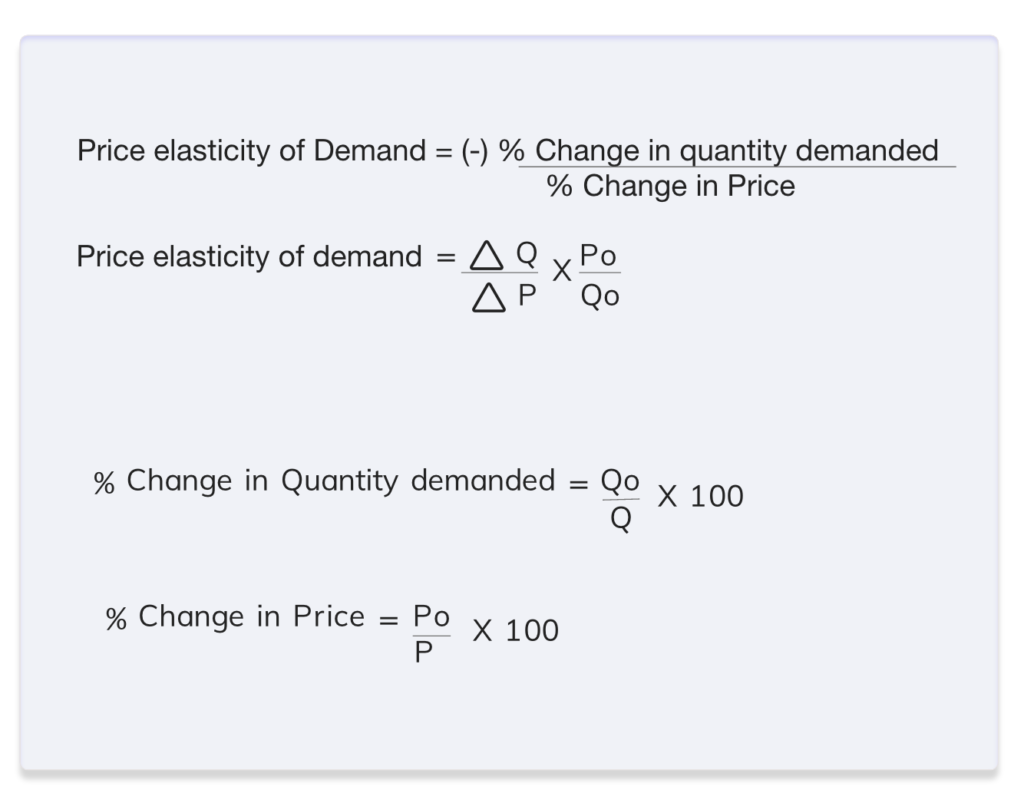
1. Due to a 10% fall in the price of a commodity, the demand rises from 100 units to 120 units. How much percentage will its demand fall, due to a 10% rise in its price?
Answer. Here, Change in demand = 20 (How? 120-100)
So, percentage change in demand = Change in demand x 100/ Original (old) demand
Percentage change in demand = 20 x 100/100 = 20%
This is only obtained from this part of the question “Due to a 10% fall in the price of a commodity, the demand rises from 100 units to 120 units”
Now, first, find price elasticity of demand = Percentage change in quantity demanded / Percentage change in price
Price elasticity of demand = 20%/10% = (-) 2
Now, consider this part of the question ‘How much percentage will its demand fall, due to a 10% rise in its price?’
We have a Price elasticity of demand = (-)2
Now price is rising by 10%
We need to find a percentage change in demand fall.
Ped = Percentage change in demand/ Percentage change in price
2 = percentage change in demand/ 10%
So, percentage fall in demand = 2 x 10 % = 20%
2. A consumer spends Rs 100 on a good priced at Rs 4/unit. When its price falls by 50%, the consumer continues to spend Rs 100 on that good. Calculate the Price elasticity of demand.
Answer. Spending = Price x Quantity demanded.
So, if a consumer spends 100 on a good price at Rs 4/unit

Now, if the price falls by 50%, that is, the new price is (4 x 50%) = 2, Consumer spends Rs 100.

Ped = Change in demand x Original Price/ Change in price x original demand
Ped = 25 x 4 / 2 x 25 = (-) 2
3. There is a 50% fall in the price of the commodity. But the quantity demanded remains to be 150 units. Find elasticity of demand.
Answer. In this question, even if the price falls by 50%. The new quantity demanded remains to be at 150 units.
So, it is like this;
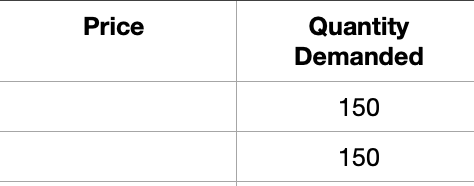
We have a percentage change in price = 50%
% change in demand = 0x 100/150 = 0%
Ped = % Change in demand / % Change in price = 0 / 50% = 0
Ped = 0
4. A certain quantity of the commodity is purchased when its price is Rs. 10 per unit. Quantity demanded increases by 50% in response to a fall in price by Rs. 2 per unit. Find elasticity of demand.
Answer. Here, we have original price as Rs 10 and change in price is Rs 2, which means new price is Rs 8 (Why? Because there is fall in price)
Elasticity of demand = % change in quantity demanded/ % change in price
% Change in price = 2 x 100/ 10 = 20%
Elasticity of demand = 50% / 20% = (-) 2.5
5. At a certain price of the commodity quantity purchased is 150 units. When the price falls by 25%, the quantity purchased increases by 75 units. Find elasticity of demand.
Answer. The original quantity demanded is 150 units
The new quantity demanded is 150 + 75 = 225 units (How? the quantity purchased has increased by 75 units)
% change in price = 25%
Elasticity of demand = % change in quantity demanded / % change in price
% change in quantity demanded = 75 x 100/ 150 = 50%
Elasticity of demand = 50 % / 25% = (-) 2
6. Price elasticity of demand is found to be (-)2. Price falls from Rs. 10 per unit to Rs. 8 per unit. Find the percentage change in quantity demanded.
Answer.
7. For a commodity, ΔP/P = -0.2, and elasticity of demand = (-) 0.3. Find the percentage change in quantity demanded.
Answer. Let’s find % change in price first.
% change in price = (ΔP/P ) x 100 = 0.2 x 100 = 20% (Fall in price, as – sign is given)
Now, Ped = % change in quantity demanded/ % change in price
0.3 = % change in quantity demanded / 20%
% change in quantity demanded = 20 x 0.3 = 6%
8. For a commodity, ΔP/P = -0.2, and elasticity of demand is 0.5. Find quantity demanded after a fall in price when initially it was 60 units.
Answer. Let’s find % change in price.
% change in price = (ΔP/P) x 100 = 0.2 x 100 = 20% (fall in price)
Original quantity demanded is given as 60. New demand is to be calculated.
Ped = % change in quantity demanded / % change in price
0.5 = % change in quantity demanded / 20%
0.5 x 20 = Change in quantity demanded x 100 / Original demand
10 = Change in quantity demanded x 100 / 60
10 x 60 = Change in quantity demanded x 100
600/ 100 = Change in quantity demanded
Change in quantity demanded = 6
Now, since the price has decreased, the quantity demanded will increase (Why? As per the law of demand, there exist an inverse (opposite) relationship between price and quantity demanded)
New quantity demanded = Original Demand + Change in demand
New quantity demanded = 60 + 6 = 66
9. A commodity shows Ed = (-)2, Quantity demanded reduces from 300 units to 150 units. In response to an increase in price. Find the increased price when initially it was Rs. 20 per unit.
Answer.
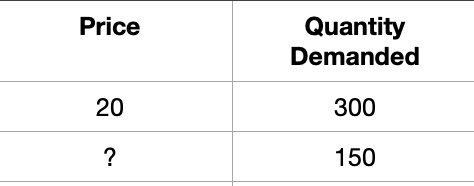
First thing, since quantity demanded has decreased. This implies the price will increase from 20.
Now, using the proportionate method formula

Ped = (150 x 20) / ( Change in price x 300)
2 = 10 / Change in price
Change in price = 5
New price = Original Price + Change in price = 20 + 5 = 25 (Why? Because when demand decreases, price increases)
10. Price elasticity of demand for a good is (-)1. At a given price the consumer buys 60 units of the good. How many units will the consumer buy if the price falls by 10 percent?
Answer. Original Quantity demanded = 60 (at a given price)
% change in price = 10% (Fall, this means demand will definitely be higher then 60)
Ped = % change in quantity demanded / % change in price
1 = % change in quantity demanded / 10%
% change in quantity demanded = 10%
Change in demand x 100 / Original demand = 10%
Change in demand x 100 / 60 = 10%
Change in demand = 10 x 60 / 100 = 6
Now, new quantity demand = Original demand + Cange in demand = 60 + 6 = 66 (We added the change because there is a fall in the price)
11. The price elasticity of demand of a good is (-) 4. If the price increases from Rs. 10 per unit to Rs. 12 per unit, what is the percentage change in demand?
Answer. Let’s find out % change in price = Change in price x 100 / Original price
% change in price = 2 x 100/ 10 = 20%
Ped = % change in quantity demanded / % change in price
4 = % change in quantity demanded / 20%
% change in quantity demanded = 80%
12. At a given market price of a good, a consumer buys 100 units. When price increases by 40 percent he buys 80 units. Calculate the price elasticity of demand.
Answer. Original demand = 100
New demand = 80
% change in price = 40%
Ped = % change in quantity demanded / % change in price
% change in quantity demanded = 20 x 100 / 100 = 20%
Ped = 20%/ 40% = 1/2 = (-) 0.5
13. A consumer buys a certain quantity of a good at a price of Rs. 10 per unit. When the price falls to Rs. 8 per unit, she buys 40 percent more quantity. Calculate the price elasticity of demand by percentage method.
Answer. Original price = 10, new price = 8
% change in demand = 40%
Ped = % change in quantity demanded / % change in price
% change in price = 2 x 100 / 10 = 20%
Ped = 40%/20% = (-) 2
14. A consumer buys 80 units of a good at a price of Rs. 4 per unit. When the price falls, he buys 100 units. If the price elasticity of demand is (-) 1, find out the new price.
Answer.
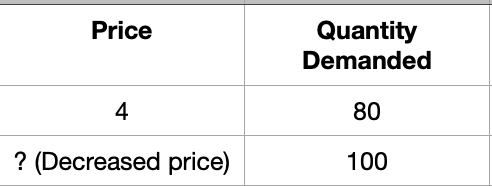
Using proportionate method formula

1 = 20 X 4/ Change in price x 80
Change in price = 1
Now, new price = Original Price – Change in price = 4 -1 = 3 (Why? Because demand has increased)
15. A consumer buys 40 units of a commodity at a price of Rs. 5 per unit and his price elasticity of demand is (-) 1.5. Calculate the amount he will buy at the price of Rs. 4 per unit of the commodity.
Answer.
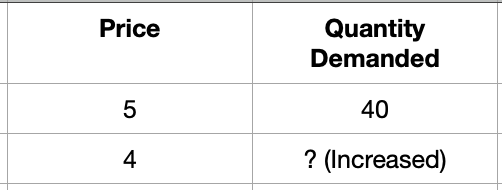
Using proportionate method;
1.5 = Change in Q X 5/ 1 X 40
1.5 X 40/ 5 = Change in Q
12 = Change in Q
New quantity demanded = Original demand + Change in Q = 40 + 12 = 52
16. A household increases its demand for a commodity from 40 units to 50 units when its price falls by 10%. What is the price elasticity for the commodity?
Answer. Let’s find % change in quantity demanded = 10 x 100/ 40 = 25%
Ped = 25%/10% = (-)2.5
17. A consumer spends Rs. 80 on a commodity when its price is Re. 1 per unit and spends Rs. 96 when the price is Rs. 2 per unit. What is the price elasticity of demand for the commodity?
Answer.

Spending = PXQ
Ped = 32 x 1/ 1 x 80 = 32/80 = 8/20 = 4/10 = (-) 0.4
18. Price of good rises from Rs. 4 to Rs. 5 per unit. As a result, its demand falls from 200 units to 100 units. Calculate Ep.
Answer.
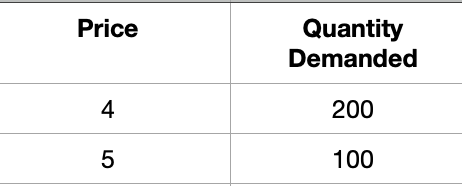
Ped = 100 x 4 / 1 x 200 = (-) 2
19. A consumer buys 50 units of a good at Rs. 10 per unit. At a price of Rs. 8 per unit, he buys 100 units. Find out Ep.
Answer.
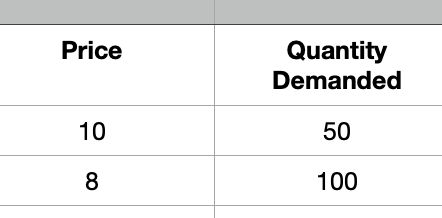
Ped = 50 x 10 / 2 x 50 = (-) 5
20. A 7% fall in the price of a good leads to a 49% increase in demand for that good. Find out Ep.
Answer. Ped = 49%/7% = (-) 7
21. Ep of good is – 3. At a price of Rs. 8 per unit, a consumer buys 160 units of the good. How many units of the good will the consumer buy when the price falls to Rs. 6 per unit?
Answer.
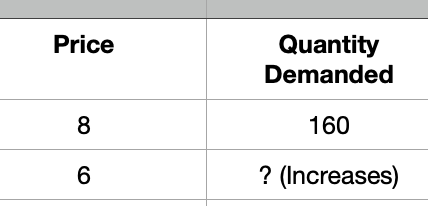
3 = Change in Q X 8 / 2 x 160
3 x 40 = Change in Q
Change in Q = 120
New Q = Original Q + CHANGE IN Q = 160 + 120 = 280
22. Ep of good is – 5. At a price of Rs. 10 per unit, the consumer buys 200 units. At what price will he buy 100 units?
Answer.
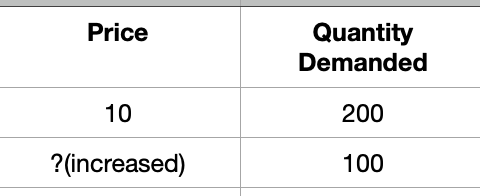
5 = 100 X 10/ Change in P X 200
5 = 5/ Change in P
Change in P = 1
New Price = Original Price + Change in P
New Price = 10 + 1 = 11
23. Ep of good is – 4. When the price of this good rises from Rs. 5 to Rs. 6 per unit, a consumer buys 40 units less. How many units did he buy at Rs. 5?
Answer. Here, Change in demand is given as 40
Let’s use proportionate method
4 = 40 x 5/ 1 x Original Demand
Original Demand = 200/4 = 50
24. Given Ep = -1, complete the following table: Use percentage change method
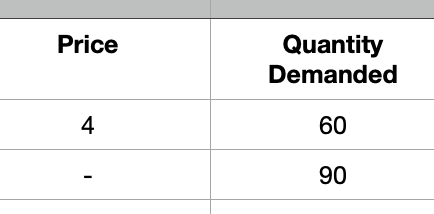
Answer. % Change in Demand = 30 x 100 / 60 = 50%
% Change in P = Change in P X 100/ 4
% Change in P = 25 Change in P
Ped = 1
1 = 50%/ 25 Change in P
Change in P = 2
Now, New Price = Original Price – Change in P = 4 – 2 = 2 (Why? because demand has increased)
In case of any more doubts, you can leave a comment.
This post is inspired after getting several emails on the solutions to the numerical price elasticity of demand.
Disclosure: Some of the links on the website are ads, meaning at no additional cost to you, I will earn a commission if you click through or make a purchase. Please support me so that I can continue writing great content for you. Subscribe



solution to question number 6 is wrong i guess because the initial price should be take as 10 instead of 8 , hence it changes the final answer
Thank You Vikhyat, I have updated solution 6. Please take a look. Happy Learning!
The 6th answer is wrong!!
It should have been divided by 10 as it is its original price!
Thank you Siddhant for your feedback, I have updated the 6th answer.
Happy Learning!
Thank You Vikhyat and Siddhant. I have updated solution 6. Happy learning!
Maam expenditure wale question isme aur join kr dijiye